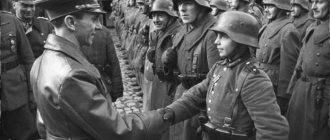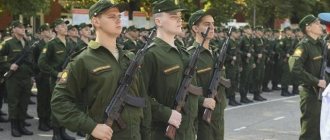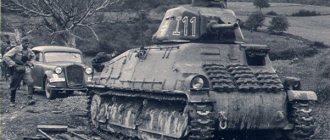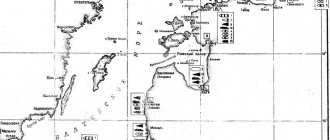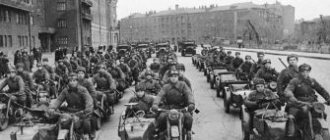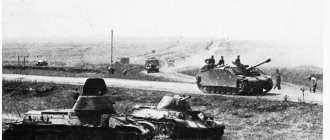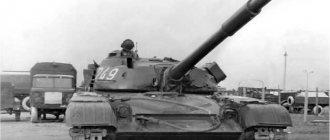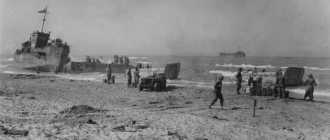Comparison of divisions of the Red Army and Wehrmacht
Any book that claims to analyze the events of the Second World War (meaning the confrontation between the USSR and Germany) cannot do without a comparison of the forces of the Red Army and the Wehrmacht. Heated debates flare up around which side had superior forces at one time or another during the war. In determining the balance of forces, they usually look for the reasons for both victories and defeats.
This is, in general, true - whoever is stronger in a given period will win. You can say the other way around - whoever won was stronger.
But the stumbling block in these disputes is the method of determining who was stronger and due to what. Some prove they are right based on an arithmetic comparison of the number of personnel of the parties, others compare forces by the number of tanks, guns, aircraft, others throw into the balance the weather, the provision of material resources, the training of personnel, the combat qualities of weapons, and the morale of soldiers.
I agree that each of these factors influences, to one degree or another, the course and outcome of the war. But the trick is that all these factors act simultaneously and influence not only the degree of strength or weakness of the parties, but also mutually influence each other. The same factor, with a certain combination of other factors, can play a huge role, or it may not play any roles in general in this particular case.
In a word, determining the strengths of the sides is not arithmetic, but algebra, and algebra of a higher order, where there are not and cannot be clear and unambiguous answers, as in school problems.
And by and large, we can determine which of the opponents is stronger only by the outcome of the armed struggle - whoever won was stronger. Everything else is from the evil one.
However, it is necessary to consider and analyze the battles of past wars. It is necessary at least in order to know more or less correctly which of the above (and left outside the attention of the author) factors influences the course of battles in a given specific situation and how it is combined with other factors. From here, by extrapolation, one can draw conclusions with some degree of accuracy about how to build one’s armed forces for the future.
Most major military scientists, military historians, and generals, when analyzing past wars, especially wars of the 20th century, take such a large military unit as a division as a strong point of reasoning. It is from this angle, that is, the numbers of divisions begin to dance.
Divisions also appear in the works of historians, writers, and publicists who are of lower rank and have less military knowledge. A very convenient unit of reasoning for them is the division. And it’s easy to count them and draw conclusions too. And the most valuable thing is that you can count in a way that is more convenient. You can compare opponents by the total number of divisions, then the picture of the war is seen in this light, or you can compare them by the number of personnel in the divisions, and then the picture appears in a completely opposite light. Or you can pull it out from the divisions and compare the number of tanks. At this point one can simply wonder how the opposite side could survive at all (the pseudo-historian V. Rezun loves to do this). You can also compare the divisions by the number of horses and giggle joyfully - well, how can we write that the German divisions were technically equipped if they have twice as many horses in the division as we do (the same Rezun).
But even here, comparing divisions is not arithmetic, but algebra. Even arithmetic data here must be compared not individually, but together. And even more so, divisions cannot be compared based on one or two factors.
But still, in order to compare the Wehrmacht division and the Red Army division, we cannot do without arithmetic. Through arithmetic we will try to shed some light on algebra.
In order not to torment the reader for a long time, especially one who does not have enough strength or time to get to the end of this article, let’s say right away - compare the forces of the Red Army and the Wehrmacht according to the principle
"Division of the Red Army = Division of the Wehrmacht"
completely wrong. This formula should be something like this (at least up to the age of 44):
“1 division of the Wehrmacht = 2-3 divisions of the Red Army”,
those. two or three divisions of the Red Army are equal in strength to one division of the Wehrmacht. Well, even simpler, considering that an army corps is usually about three divisions, it turns out that a German division is equal to a Soviet army corps. Accordingly, the corps is equal to the army, the army to the front.
Now, if you begin to compare the forces of the Red Army and the Wehrmacht, especially in 41-42, then the picture of those events will appear before you in a slightly different light.
Well, for those who are never convinced by unfounded statements, let’s continue. Let's start with simple arithmetic - compare the same indicators of the divisions of both sides.
Table 1 Soviet rifle division and German infantry division -41g.
| SD RKKA | PD Wehrmacht | Ratio | |
| Personnel (persons) | 10858 | 16859 | 1-1.55 |
| Rifles, carbines | 8341 | 10691 | 1-1.28 |
| Machine guns, machine guns | 468 | 1380 | 1-2.95 |
| Mortars | 78 | 138 | 1-1.77 |
| Field artillery guns | 36 | 74 | 1-2.06 |
| Anti-tank guns | 18 | 75 | 1-4.17 |
| Anti-aircraft guns | 10 | 12 | 1-1.2 |
| Cars | 203 | 902 | 1-4.44 |
| Weight of one salvo (kg) | 547.8 | 1660.6 | 1-3.03 |
| Total ratio | 1 -2.48 |
In this table we entered data on division staffs, without being distracted by the actual availability of these funds in the division, although it is well known that the condition of Soviet divisions at the beginning of the war left much to be desired. But even in terms of personnel, the Soviet rifle division is two and a half times weaker than the German one.
We will not bore the reader with tables by year. Let us only note that in 42-43 the ratio changed to 1-1.92, i.e. the German infantry division was still almost twice as strong as the Soviet rifle division; in 1944, the Soviet rifle division was already slightly stronger than the German one (1-0.91). This ratio changed in 1945 to 1-0.81. Those. at the end of the war, the Soviet rifle division was somewhat stronger than the German one.
But maybe things are different with tank formations? Let's say infantry is infantry. Maybe the German tank divisions fought “not with numbers, but with skill.” After all, it is well known that approximately 20-23 thousand Soviet tanks opposed 3-4 thousand German ones, which Rezun and others like them count with such ecstasy and delight. Let's compare.
Table 1 Soviet and German tank divisions -41.
| TD Red Army | TD Wehrmacht | Ratio | |
| Personnel (persons) | 10942 | 16932 | 0.65-1 |
| Field artillery guns | 28 | 58 | 0.48-1 |
| Mortars | 45 | 54 | 0.83-1 |
| Anti-tank artillery guns. | 12 | 101 | 0.12-1 |
| Anti-aircraft artillery guns | 12 | 63 | 0.19-1 |
| Tanks and self-propelled guns | 375 | 200 | 1.88-1 |
| Cars | 1360 | 2147 | 0.63-1 |
| Total ratio | 0.6-1 |
So, we see that in 1941 the Soviet tank division was almost twice as weak as the German tank division. After all, the power of a division, even a tank one, is not determined by tanks alone.
The above data is taken from Soviet sources. But maybe this data was manipulated? It is generally accepted today that all Soviet military-historical literature is false and subordinated to the desire of the communists to distort history in their own interests.
Okay, let's turn to German authors.
Chief of Staff of the 17th Army Corps of the Wehrmacht, Major General Hans Doerr. In his book “The March on Stalingrad” he provides the following data for August 1942:
| According to the Eastern Armies Department of the OKH Intelligence Directorate, by mid-August 1942. Russia had the following forces: | |
| 407 rifle divisions, | equal to 287 German |
| 178 rifle brigades, | equal to 142 German |
| 39 cavalry divisions, | equal to 33 German |
| 165 tank brigades, | equal to 63 German |
| Total 789 connections, equal to 593 German |
Below, Doerr compares formations on the Eastern Front. 254 infantry divisions = 134 German, 83 infantry brigades = 46 German, 13 cavalry divisions = 7 German, 68 tank brigades = 34 German.
Note that the Wehrmacht had only one cavalry division. Doerr simply gives comparative data. As a result, he equates 418 formations of the Red Army with 222 German formations.
But maybe Doerr is wrong? Although he is the chief of staff of the corps, he is still only a major general. Let's turn to another German author.
Field Marshal Erich von Manstein. One of the most outstanding German commanders of the Second World War. He began the war against the USSR as commander of the 56th Tank Corps, his last position being commander of Army Group South. One must assume that this general knows what he is writing.
Here are the lines from his book “Lost Victories” (we are talking about the summer of 1943): “The striking force of one Soviet tank corps corresponded approximately to the strength of a German tank division. The mechanized corps was superior to the German motorized division, since the corps had a tank brigade.”
Note that Manstein compares the Soviet corps with a German division, but not division with division.
But maybe the reader considers this evidence insufficient?
Okay, let's raise the bar. Oberst General Franz Halder is the head of the OKH, i.e., in our language, the chief of the General Staff of the Ground Forces until the fall of 1942, in fact, the head of the Wehrmacht’s combat operations on the Eastern Front, the third most important figure in the German Armed Forces after Hitler and Keitel .
Here is his famous war diary. Entry dated August 28, 1941: “...110 enemy divisions (in terms of their combat effectiveness they correspond to 65 of our divisions), in the second line and in the rear 40...".
Or here is the entry dated July 31, 1941: “...The armies” included in the “fronts” are, apparently, something of our corps, to which several divisions are subordinated.”
Here we see that Halder equates the Soviet army with the German corps.
We can no longer raise the bar any higher. Keitel did not pay attention to this issue in his dying memoirs “Reflections before Execution”. He was more busy with self-justifications and descriptions of intrigues and squabbles in the OKW and Hitler's headquarters.
Hitler also did not leave memoirs or analyzes of the armed forces.
And we do not find any information from any German general that the Soviet division was superior to the German one in strength. They write about the overall superiority of the Red Army formations opposing them in artillery, tanks, aircraft, people, about the outstanding abilities and stamina of their soldiers and officers, etc. etc., but never about the fact that the Soviet division is equal to the German one. And you shouldn’t giggle when reading about how a German division defeated the Soviet corps. This does not mean at all that the Germans, with their military skill, defeated the Soviet forces three times superior. No, the battle was fought on equal terms and here victory was on the side of the Wehrmacht.
I agree that military skill and training play a huge role in combat and combat, but when you sit down to calculate the balance of forces, it is worth remembering that divisions are not always equal to each other.
Here I did not set myself the task of comparing Soviet and German divisions by strength, taking into account their manning, provision of weapons and equipment, training, combat experience, and quality of weapons. I tried to compare divisions only by their personnel structure. If we take into account other factors, it will turn out. that the Wehrmacht in 41-42 had an overwhelming advantage over the Red Army. And in light of this, one can only wonder how the Red Army managed to survive. And re-reading the memoirs of German military leaders, you always see how they painfully search for an answer to the question - how and why it happened, that with obvious and multiple superiority, the Wehrmacht was defeated.
Literature
1.Military history magazine No. 3-1995. 2. G.F. Krivosheev and others. Russia and the USSR in the wars of the 20th century. Losses of the Armed Forces. Statistical research. Moscow. OLMA-PRESS. 2001 3. Magazine “Technology for Youth”. No. 8-1999 4. Fatal decisions. G. Doerr. March to Stalingrad. St. Petersburg. POLYGON. 2001 5. E. von Manstein. Lost victories. AST.Moscow, Phoenix. Rostov-on-Don. 1999 6. F. Halder. From Brest to Salingrad. War diary. Rusich. Smolensk 2001 7.Encyclopedia of the Third Reich.Lockheed Myth. Moscow. 1996 8.B.Müller-Hillebrandt. German Land Army 1933-1945 Directory. Isographus. EXMO. Moscow. 2002 9.V.Keitel. Reflections before execution. Rusich. Smolensk 2000
LiveInternetLiveInternet
Member of the German armed forces (Wehrmacht) in 1941-1945. included:
- Ground troops;
- Air Force;
- Navy:
- SS troops. Since 1940, the Wehrmacht also included SS field troops. They were operationally subordinate to the Wehrmacht High Command, but at the same time had a certain independence.
The High Command of the Wehrmacht OKB (Oberkommando der Wehrmacht) was the main governing body of the German armed forces. It was created on February 4, 1938 on the basis of the abolished War Ministry. On the same day, Reich Chancellor and Fuhrer of the NSDAP A. Hitler assumed command of all German armed forces. The OKB included: 1. Operational leadership headquarters with national defense, propaganda and operational departments, as well as its own communications service. The Chief of Staff of the operational leadership of the armed forces was given the right to personally report to A. Hitler; 2. Central management. It ensured the work of the OKB Headquarters. Along with the department for ensuring the deployment and operation of the headquarters, it also included departments dealing with issues of personnel of the armed forces, interaction between the branches of the military and OKB personnel; 3. The Military Intelligence Directorate, known as the Abwehr. The tasks of this department are indicated by the names of its departments: 1st - intelligence; 2nd - sabotage, sabotage; 3rd - counterintelligence. The Directorate also had a central department and a management group that collected information through military attaches abroad. On February 12, 1944, most of the Abwehr became part of the Main Directorate of Imperial Security of the RSS (RSHA), and on June 1, 1944, the Military Intelligence Directorate was liquidated; 4. General management with the departments of special training, scientific research, construction, prisoners of war, pensions; 5. Department of Armaments and War Economy. This department was one of the main ones within the OKB. It included departments of military industry, military economics, raw materials, contracts and prices service, military-economic inspections and the central office. The OKB also administered the Wehrmacht Academy, the Imperial Military Court, the administrative, legal and military-historical departments, the prisoner of war service and the sanitary service.
In its activities, the OKB was subject to the instructions of the Reich Defense Council, which led the country's preparations for war. It was created on April 4, 1935 and reorganized in accordance with the Law “On the Defense of the Empire” of September 4, 1938. The Council acted in the following composition: A. Hitler (chairman); G. Goering (vice-chairman); commanders-in-chief of the branches of the armed forces, head of the OKB, deputy Fuhrer for the party, head of the Imperial Chancellery, chairman of the Privy Council, general commissioner for the imperial administration, general commissioner for economic affairs, ministers of foreign affairs, internal affairs, finance, public education and propaganda, chairman of the board of the Reichsbank.
Ground Forces The main control body of the ground forces was the Supreme Command of the OKH Ground Forces (Oberkommando des Heers - OKH). The date of creation of the OKH was January 11, 1936. The most important component of the OKH was the General Staff of the Ground Forces, the highest authority for planning military operations. The OKH also included: the Army Personnel Directorate; -General management; -Commander of the reserve army with his staff; -Department of Armaments of the Ground Forces; -Administrative management; -Management group for budget and salary.
Infantry German regulations considered infantry as the main branch of the military. The remaining troops were called upon to support her. The term “infantry” (die Infanterie) in the Wehrmacht designated troops fighting on foot - riflemen, grenadiers, rangers, mountain riflemen and dismounted motorized infantry of armored forces. The main tactical formation of the German infantry was the infantry division (die Infanteriedivision), intended to carry out combat missions as part of a corps, army or other formations, as well as independently. At the initial stage of the deployment of the Wehrmacht, the formation of new infantry divisions was carried out at an extremely fast pace: in 1932 there were 7 such divisions, in 1935 their number was 24, in 1938 - 35, and by the beginning of the Second World War there were already 86 infantry divisions , and in addition, 3 mountain, 4 motorized and 4 light infantry divisions. At the same time, the material and technical base was not yet sufficiently developed, and there was an acute shortage of trained personnel. In this regard, it was not possible to form divisions according to single states and it was necessary to resort to improvisation. This is how different types of divisions arose, to denote which the term “wave” (die Welle) was introduced. For example, 35 infantry divisions created before 1938 belonged to the 1st wave. They were considered personnel divisions of the peacetime army, and although some of their units had to be formed anew during mobilization, the combat effectiveness of these divisions was quite high. They were based on 3 infantry regiments of 3,049 soldiers and officers. The regiment consisted of 3 infantry battalions, a company of infantry guns and an anti-tank company. Each infantry battalion included 3 rifle companies (201 people each) and a machine gun company (190 people). In turn, the rifle company consisted of three rifle platoons of 50 people each. The infantry gun company, in addition to six light 75-mm guns, had two very powerful 150-mm guns, and the anti-tank company had twelve 37-mm anti-tank guns.
Despite the objections of General G. Guderian, who sought to concentrate all tanks and vehicles in tank divisions, the anti-tank companies of the infantry regiments were fully motorized. Although the head of the General Affairs Directorate of the Ground Forces, General F. Fromm, explained this decision only by the fact that “the infantry also needs to have several vehicles,” it turned out to be extremely successful. Thanks to vehicles, anti-tank companies always found themselves in the right place at the right time. Along with the “standard” infantry divisions, the German command formed infantry divisions of a special organization for use in the war against the USSR. First of all, we are talking about four light infantry divisions (97th, 99th, 100th, 101st), which were called Jaeger divisions in some Wehrmacht documents. These divisions were intended to operate in off-road conditions in wooded and mountainous terrain and occupied an intermediate position between infantry and mountain ranger divisions. Each such formation included 2 infantry regiments of three battalions, a reconnaissance battalion consisting of 2 scooter and 1 anti-tank companies, a two-company anti-tank battalion, engineer and field reserve battalions, as well as a communications battalion. The organization of an artillery regiment differed from the organization of an ordinary divisional artillery regiment. In it, only one light division had three batteries, and the rest, including the heavy one, had two batteries, 4 guns in each battery. Another feature of the light infantry divisions was that their main means of transport were peasant carts. The elite light infantry units were the German mountain ranger divisions, designed to conduct combat operations in mountainous conditions. By the time of the attack on the USSR, the Wehrmacht had mountain ranger divisions, staffed mainly by natives of the mountainous regions of Germany and Austria (a total of 11 such divisions were formed before the end of the war). The personnel of the divisions underwent intensive mountaineering training; they were armed with special types of small arms and light guns and howitzers, transported disassembled on pack animals. The infantry divisions of a special organization also included 9 security divisions of the 16th wave, formed to fight partisans and protect communications in the front-line zone. Each of these formations included a headquarters with a communications company and a field commandant’s office, a combat group consisting of 1 infantry regiment of three battalions (each battalion has 3 rifle companies and 1 machine gun company), an anti-tank company (12 37 mm guns), a company of infantry guns (6 light infantry guns), a light artillery division (3 batteries of 105 mm howitzers) and a light infantry fleet, as well as a minimum number of rear units. In addition, in special cases, from the OKH reserve troops, the security divisions were to be assigned engineer-construction and security units, as well as field gendarmerie detachments. In addition to the above infantry formations, before the attack on the USSR, the Wehrmacht also had 32 infantry divisions of limited combat capability, which were used to protect the sea coast and perform occupational service in France, Norway and the Balkans. Of particular interest are two more types of infantry divisions formed by ground forces during the war. We are talking about field training and depot divisions. Field training divisions were intended to quickly replace unexpectedly high personnel losses. The idea was this. that conscripts, after completing the basic training course in Germany, had to continue serving in field training divisions stationed in the front-line zone. In the units of these divisions, soldiers improved their combat training, performed various security tasks and, as necessary, were involved in counter-guerrilla operations. At the same time, field training divisions could transfer reinforcements to divisions operating at the front line quite quickly, since they were located in close proximity to them. The creation of depot divisions was based on the fact that infantry, anti-tank and artillery units suffer particularly heavy losses in combat situations. The losses of headquarters, divisional communications battalions, units and rear services are relatively small. Therefore, it seemed advisable to quickly restore the combat effectiveness of defeated infantry divisions by combining them with depot divisions that had undergone combat training. In accordance with this purpose, the depot division consisted of two infantry regiments, in each German army 1941 - 1945. - The organization consisted of 3 battalions, a company of infantry guns and an anti-tank company; one divisional company of anti-tank guns, one mixed artillery battalion, one engineer battalion, as well as reduced-strength rear units. According to German historians, depot divisions as a form of training reserve reserves did not justify themselves. Due to the rapid succession of defeats at the front, these divisions did not meet the deadlines required for combat training. In addition, it turned out to be impossible to achieve cohesion among such units. The consequence of this was constantly growing losses of personnel.
Armored troops Tank troops (die Panzertruppen) until March 25, 1943 were called “mobile troops” (die schnelle Truppen), and even earlier - “vehicle troops” (Kraftfahrkampftruppen). The tank forces included: tank battalions and tank regiments, motorized regiments of tank and motorized divisions, anti-tank divisions, mobile battalions (without scooter and cavalry units), reconnaissance tank battalions, into which reconnaissance and motorcycle battalions of tank and motorized divisions were reorganized, and also armored trains. Since tank forces most closely corresponded to the desire of the German command to conduct offensive operations, already from the mid-20s. In Germany, work was carried out on the creation and combat use of these troops, as well as the design of military equipment for them. With the National Socialists coming to power in Germany, the green light was given to the organization of tank forces, and by October 15, 1935, the Wehrmacht had its first three tank divisions. When forming them, German generals took into account the experience of creating similar formations in the USSR, as well as the developments of some British military researchers. Therefore, the organizational structure of the German tank division of the 1935 model quite successfully combined tank, motorized infantry and artillery units, and had the necessary communications and engineering support services. The number of personnel of the tank division was 14,373 people. It is noteworthy that, contrary to the desire of the creators of the German tank forces, Generals G. Guderian, O. Lutz and von Thoma, to unite all tank and motorized units and subunits as part of tank divisions, in 1935-1936. The formation of tank brigades intended only to interact with infantry was carried out. In 1936, the first such brigade, the 4th, was organized in Stuttgart. Somewhat later, another brigade was formed - the 6th. Both brigades included two two-battalion tank regiments and the necessary support units.
Although no one disputed the need for tank units to directly support infantry, the Wehrmacht still did not repeat the mistake of the French army and did not allow the tank fleet to be dispersed among numerous tank battalions and brigades of direct infantry support. As for tank divisions, their number steadily increased. In the fall of 1939, during the battles in Poland, the Wehrmacht already had 6 tank divisions, and by 1940, when the Western campaign began, their number increased to 10. This was achieved thanks to an increase in the production rate of armored vehicles in Germany itself , the adoption of Pz tanks captured in Czechoslovakia and new ones produced there. Kpfw: 35 (t) and Рz. Kpfw. 38 (t), as well as through the reorganization of four light divisions created in the second half of the 30s into tank divisions. Preparations for the attack on the USSR were also accompanied by an almost doubling of the number of tank divisions - by June 1941 there were 20 of them. However, if the creation of additional tank divisions before the Western campaign was a “replication” of the organizational structure of the tank division of the 1935 model, then those prepared for the campaign in the East, tank divisions received a new organizational structure. Instead of two tank regiments, these divisions had only one, while the number of motorized infantry regiments was increased to two. The tank division of the new organization also included an artillery regiment, a motorized anti-tank fighter division with an anti-aircraft company (sixteen 20-mm self-propelled guns) and five battalions - motorcycle rifle, reconnaissance, engineer, communications and field reserve. The division consisted of 16 thousand people, 192 guns (including 53 anti-tank ones) and 25 armored vehicles. The number of tanks in divisions varied (from 135 to 209 vehicles). Thus, if in 1940 there were about 3000 unarmored wheeled vehicles per 300 tanks, then in 1941 this ratio became even more unfavorable. The created situation contradicted combat experience. This manifested itself especially sharply in those cases when, during the offensive, advanced tank units were forced to stop only because the second echelons and rear units, following them on wheeled vehicles, got stuck in the mud. The presence in the division of tanks and wheeled vehicles that were completely different in speed and tactical capabilities constantly led to its breaking into several parts. It often happened that wheeled vehicles, moving along ordinary roads or highways, went far ahead of the tanks. In other cases, tanks, moving off roads, broke away from the motorized infantry following them or were forced to move at infantry speed, which clearly contradicted the basic principles of using tank forces. During the war, the German command did a lot to increase the combat effectiveness and mobility of tank divisions. Generalization of the experience of combat operations at the beginning of the Eastern campaign led at the end of 1941 - beginning of 1942 to the decision to make the reconnaissance and motorcycle battalions included in the tank divisions of the same type in composition. Further developments in military events led in 1943 to a new reorganization of reconnaissance battalions, called tank reconnaissance battalions. After the reorganization of 1943, a tank reconnaissance battalion consisted of a company of armored vehicles, a company of armored personnel carriers, two motor reconnaissance companies, a company of heavy weapons and a supply company. In the summer of 1944, the organization of tank divisions underwent new changes. This time the number of tanks in each company decreased from 22 to 17 units. In March 1945, the tank units of the tank divisions were again reduced - in each division, along with two motorized tank-grenadier regiments, only one tank regiment remained. It included one tank battalion, consisting of four companies of 10 vehicles each, and two companies were fully equipped with Pz tanks. Krfw. IV, and two more - Pz. Krfw. V (“Panthers”). The second tank battalion was replaced by a motorized armored personnel carrier battalion or an assault gun battalion. Thus, unlike the armies of the USSR, USA and Great Britain, the number of tanks in the Wehrmacht tank formations steadily decreased, and the striking power of these formations weakened. In total, the German ground forces formed 38 tank divisions: 1st to 27th, 232nd, 233rd, tank training, “Norway”, “Feldherrnhalle”, “Feldherrnhalle I”, “Holstein”, “Silesia” , "Yuteborg" and "Müncheberg".
Cavalry According to the Treaty of Versailles, the German armed forces were only allowed to have 3 cavalry divisions. Each of these divisions included a headquarters, six cavalry regiments, a training squadron, a horse artillery division, and logistics units. The cavalry regiment consisted of 4 saber squadrons and a machine gun platoon. The total strength of the cavalry division was 5,300 people. The above structure was maintained for more than 10 years. During the war in the East, separate cavalry regiments “North” were organized by army groups. The reconnaissance battalions of infantry divisions served as the basis for their formation. From these regiments, 2 cavalry brigades were formed: the 3rd and 4th. The 3rd Cavalry Brigade was created in February 1944 on the basis of cavalry regiments." The 4th Cavalry Brigade was formed on the basis of the cavalry regiment "North" and units allocated from the 3rd Cavalry Brigade. In addition to the cavalry regiments, the brigades were part of artillery units and the necessary logistics services. At the beginning of 1945, the 3rd and 4th Cavalry Brigades were deployed into the 3rd and 4th Cavalry Divisions, respectively, with the inclusion of self-propelled artillery units. Both divisions fought in the East. Mention should also be made here of the numerous cavalry units, units and even formations formed from among Soviet prisoners of war and volunteers from the inhabitants of the occupied territories of the Soviet Union. Already by April 1943. The Wehrmacht included about 20 mounted Cossack regiments, each numbering from 400 to 1000 people.
Artillery Like other armies of that time, a significant part of the Wehrmacht’s artillery was military, that is, it was part of units and subunits of other branches of the military. The bulk of military artillery was infantry. Each infantry regiment had a company of infantry guns and an anti-tank company. The infantry gun companies were armed with two 150 mm heavy and six 75 mm light infantry guns. Anti-tank companies initially had twelve 37-mm anti-tank guns, but as the armor protection of enemy tanks increased, they were rearmed first with 50-mm anti-tank guns and then with 75-mm cannons. The divisional artillery regiment of the infantry division, unlike all other armies in the world, was armed only with howitzers. Three of its three-battery divisions were armed with light 105 mm field howitzers (four in each battery) and one division with heavy 150 mm howitzers. Howitzer guns, due to their smaller mass compared to guns of the same caliber, corresponded to the desire of the German command to conduct maneuver warfare. They also had very valuable qualities for waging trench warfare, namely power and accuracy. During the war, some mechanically driven howitzers in mobile formations were replaced by self-propelled howitzers, which had not only a significantly reduced preparation time for firing, but also armor protection for the crew from bullets and shell fragments. However, towed and self-propelled howitzers had a significant drawback - they could not be used effectively to fight tanks. Therefore, both the infantry and tank and motorized divisions had a separate anti-tank division or battalion of three companies. Due to the need to strengthen troops in the most important directions, the Wehrmacht command had to return to the issue of forming large artillery formations. In 1944, people's artillery corps began to be created, the basis of the organizational structure of which was 6 divisions of anti-tank, howitzer and cannon artillery. In total, the corps had 64 artillery pieces. The body was completely motorized. Typically, the artillery corps was attached to the army corps and was subordinate to the artillery commander. It was intended to reinforce artillery in the direction of the main attack of the supported army corps. The positional area of the corps occupied 8-15 km along the front. Fire and maneuver control was carried out by the commander of the artillery corps in accordance with the combat mission and the specific situation. The placement of observers in division lines provided information about the enemy necessary to control the fire of the corps. The advantages of the artillery corps consisted of centralized artillery control and a unified supply system for all units.
With centralized control of the corps, it was possible to deliver powerful fire strikes against the enemy and suppress his artillery. At the same time, the corps' fire reserves were very small. This is clearly seen if its 64 guns are compared with the 496 guns, 216 mortars and 864 rocket artillery launchers available in the Soviet breakthrough artillery corps of the 1943 model. Here it is worth mentioning the units, units and formations of rocket artillery. The first rocket artillery divisions, armed with 150-mm six-barreled launchers, began to form in 1940. These divisions belonged to the so-called “smoke troops”), which were officially intended to set up smoke screens, and unofficially - to wage chemical warfare. By 1942 The Wehrmacht had 9 separate rocket artillery divisions with 3 batteries each (a battery had 6 launchers). Another 9 divisions were consolidated into 3 rocket artillery regiments of 3 divisions each. Since the use of chemical weapons was constantly postponed, the launchers were used to fire high-explosive fragmentation and incendiary rocket mines. In 1942, rocket artillery was reorganized. In the fall, the Germans created three divisional rocket artillery commands and 6 separate motorized regiments based on the regiments. According to the decision of the General Staff of the Ground Forces, the structure of individual divisions was henceforth abolished. At the end of January 1944, the regiments were reorganized into separate brigades of three types: motorized, partially motorized and stationary. Each brigade had multi-charge installations for launching rockets of 150, 210, 280 and 320 mm caliber. The motorized brigade had seventy-two 150-mm rocket launchers, as well as eighteen 210-, 280- and 320-mm mortars. The materiel was transported on 109 tractors and 284 trucks. Personnel - 2933 people with 18 machine guns. By June 1, 1944 The German army had eight brigades of rocket artillery. In addition to them, the 101st separate heavy motorized regiment was formed, consisting of 3 three-battery divisions of rocket artillery with a caliber of 280 and 320 mm, as well as the 11th stationary division of a three-battery composition (a total of twelve 150-mm launchers and eight self-propelled 150-mm Panzerwerfers) ).By January 1945, eight more brigades were deployed, bringing the total number to sixteen. Self-propelled launchers were in service with individual rocket artillery companies. Each company had 8 launchers on the Ma-ultira armored chassis or sWS tractor, 10 armored half-track ammunition transporters and 24 trucks. Personnel - 120 people. As a rule, companies were intended to reinforce mortar brigades and were included in their composition in groups of two (in some cases three or four) companies. Rocket artillery companies also included some Wehrmacht tank and motorized divisions. Despite the significant strengthening of German rocket artillery during the war, it was never able to surpass Soviet rocket artillery, which at the end of the war had 7 divisions, 11 brigades, 114 regiments and 38 separate divisions.
Air Force (Luftwaffe) During the Second World War, the Air Force included aviation formations and formations, anti-aircraft artillery units and formations, signal troops, the Hermann Goering ground force formation, parachute troops and those formed in 1942-1943. field troops - the so-called “airfield divisions”, intended for use at the front as infantry formations. The organizational structure of aviation units and formations was well developed long before the start of World War II and remained virtually unchanged during the war. The main tactical unit of the Luftwaffe was the aviation squadron, which had three flights of 3 aircraft each, as well as 3 spare aircraft. 3 squadrons were united into an aviation unit called a “group”, which was armed with 36 aircraft. Aviation groups had significant independence and, as a rule, were based at their own airfields. Three groups with a headquarters squadron formed an aviation formation called a “squadron”. The squadron's fleet consisted of approximately 120 aircraft. The squadrons were united into aviation divisions. Typically, an air division included long- and short-range reconnaissance squadrons and a squadron of bombers, dive bombers, single-engine and twin-engine fighters. According to available data, at the beginning of the Second World War, German aviation consisted of 30 bomber groups (1,180 bombers), 13 fighter groups (771 fighters), 9 dive bomber groups (336 dive bombers), 10 fighter-bomber groups (408 aircraft) and 1 group attack aircraft (40 aircraft). To this should be added 552 transport aircraft, 23 squadrons of long-range and 30 squadrons of short-range reconnaissance aircraft (721 reconnaissance aircraft), as well as 14 squadrons of coastal aviation, 2 squadrons of naval aircraft and 2 squadrons of aircraft for aircraft carriers under construction (240 aircraft in total), which formed the core of naval aviation . In addition, there were 55 special purpose aircraft. The highest operational unit of the Luftwaffe, capable of solving operational-strategic tasks and, as a rule, interacting with the army group, was the air fleet, which consisted of several aviation corps. Along with aviation units and formations numbering 600-1000 aircraft, the air fleet also included anti-aircraft artillery units and formations, as well as units of airborne troops, which made it possible to perform a very wide range of combat missions.
The attack on the USSR involved the 1st Air Fleet, which supported Army Group North, the 2nd Air Fleet, Army Group Center, and the 4th Air Fleet, Army Group South. On the southernmost section of the front, in Romania, a separate Luftwaffe group fought. Units of the 5th Air Fleet were based in Norway and participated in operations against the USSR only sporadically, while the 3rd Air Fleet, with headquarters in Paris, fought against Great Britain. In anticipation of the Allied landing on the Mediterranean coast in the south, a kind of revival of the German airborne forces took place. In October 1942, the 1st Parachute Division was created on the basis of the 7th Air Force Division, and in the spring of 1943 the formation of the 2nd Parachute Division was completed. According to the staff of the division, it was supposed to have only 12,000 people, while the regular strength of the parachute regiment was 3,460 people. Well armed and fully equipped with well-trained personnel, the 1st and 2nd Parachute Divisions performed well in numerous small landing operations and in combat operations in Italy and the East. This allowed G. Goering to insist on the formation of another 10 parachute divisions, of which only 8 were created (from the 3rd to the 10th). Information about the 11th and 12th Parachute Divisions is very scarce; perhaps they never completed their formation. Before the end of the war, the strength of the eight created divisions was reduced to 10,000 people. At the end of July 1944, on the basis of the reorganized headquarters of the 11th Aviation Corps, the headquarters of the 1st Parachute Army was organized. The army included the parachute and army corps. Subsequently, they were added to another army corps and two brigades of assault guns, manned by soldiers and officers from the Luftwaffe. The number of personnel of the 1st Parachute Army reached 90 thousand people, and until the end of the Second World War it operated on the Western Front.
Sources of information: 1. V.N. Shunkov “Wehrmacht”
Comparative assessment of the Armed Forces of the USSR and the armies of the countries of the fascist bloc at the beginning of the war.
Vel. Otech. the war should be considered as part of the Second World War, therefore the reasons for its outbreak follow from the logic of all previous events.
In the history of the first half of the 20th century. What is noteworthy is that just 20 years after the end of the First World War, the Second began. => reasons Tue. world. wars should be sought in the peculiarities of interwar development.
In 1919, Germany was named as the sole culprit for unleashing the First. world. war. The terms of the peace treaty were extremely difficult for Germany (loss of territory, colonies, indemnity, prohibitions on owning a large army, navy, etc.).
Under these circumstances, in the post-war period, revanchist sentiments grew stronger in Germany (they will return what was lost, restore national dignity). It was on the basis of these ideas that the Nazi Party led by A. Hitler came to power in Germany in 1933.
However, in the matter of unleashing W. world. war, the peculiarities of diplomacy of the interwar period played a major role. From ser. 1930s Germany, under the leadership of the Nazi Party, begins to unilaterally violate the terms of the Versailles Peace, and the countries neighboring Germany and the United States did not take effective measures to limit the growth of German influence. On the contrary, these countries will begin to pursue a policy of appeasement
aggressor. The fact is that for the “European democracies” and the USA in the 1930s, both Germany and the USSR were different evils.
=> In the ruling circles of England, France, and the USA, the idea of pitting two opponents against each other to weaken both will prevail. => England, France, and the USA do not take measures to prevent the expansion of Germany in the East and do not prevent the strengthening of Germany’s military power.
The USSR, which found itself in the second half of the 1930s. in international isolation, which did not find support from England, France, and the USA, there was nothing left to do but make a diplomatic demarche. In 1939, the vector of the USSR's foreign policy changed dramatically.
In Aug. 1939 The USSR and Germany sign a non-aggression treaty (+ secret protocol). The Molotov-Ribbentrop Pact is assessed ambiguously in historical literature. On the one hand, he temporarily moved the danger away from the borders of the USSR, and, on the other hand, brought the beginning of the Second World War closer. world. war, because freed Germany's hands.
However, it is obvious that the pact was viewed both in the USSR and in Germany as a temporary maneuver. In 1940, a year after the start of Tue.
world. war, virtually all of Europe was under German control. To achieve world domination, Germany needed a war with the USSR.
Plans and goals of the parties.
Germany.
Plan “Barbarossa” was approved on December 18, 1940. It was planned to defeat the main forces of the Red Army west of the Dnieper and Zap rivers. Dvina (not to be allowed to retreat into the interior of the country), and then enter the Arkhangelsk-Volga-Astrakhan line, finishing the campaign before the onset of cold weather. Political and economic plans envisaged the dismemberment of the USSR into a number of independent states and the inclusion of the western territories of the USSR into the Reich.
The plan was to bring Soviet resources under control.
THE USSR.
Defend the freedom and independence of the country.
The balance of forces on the eve of the war.
By June 22, 1941, the German military command deployed its military forces on the western borders of the USSR. All troops were consolidated into three strategic groupings.
Army Group North - to the Baltics and Leningrad
Army Group Center - to Smolensk and Moscow
Army Group South - to Ukraine.
The three German army groups were opposed by troops from five Soviet border military districts (Leningrad, Baltic Special, Western Special, Kiev Special and Odessa).
| Balance of power | ||
| Germany | USSR | |
| Tanks | 4 thousand | 12 thousand (1.8) |
| Aircraft | 5 thousand | 9 thousand (1.5) |
| art. guns | 47 thousand | 37 thousand |
| human resources | 5 million | 3 million |
Deportation of Germans
At first, anti-German sentiment did not exceed the level of 1914, but as the Wehrmacht advanced deeper into the country, it intensified. Not all Germans were happy with the Soviet government and its policies, just like not all Russians: dispossession, collectivization, propaganda, repression of the intelligentsia, atheistic policies and suspicion of all foreigners did not add to the popularity of the Bolsheviks. It happened that the dissatisfied met the Wehrmacht with bread and salt. When Stalin learned about some of these facts, he made a decision quickly: he was ordered to “evict the Soviet Germans with a bang” (literally). Germans from Ukraine and Russia were evicted to the Urals, Siberia, Altai Territory and Kazakhstan. The Autonomous Republic of the Volga Germans was liquidated. On August 28, 1941, the Supreme Soviet of the USSR issued a corresponding decree.
Decree on the resettlement of Soviet Germans (fn-volga.ru)
Deportation of Germans (novastan.org)
The authorities claimed that among the Germans “there are thousands and tens of thousands of saboteurs and spies who (...) must carry out explosions...” As it turned out later, the majority of the Germans retained their loyalty and did not carry out any explosions. By May 1942, the resettlement was basically completed - 950 thousand people were forced to leave their homes. From 1942 to 1947 316 thousand of them were mobilized into the labor army - men from 15 to 55 and women from 16 to 45 (except for pregnant women and mothers of children under 3 years old) worked in conditions similar to imprisonment, often under guard, in the cold, with meager rations. They were recruited to work on construction sites, logging sites and in mines. Almost a quarter of them died.
Labor soldiers, 1942 (aussiedlerbote.de)
The moral humiliation of the Germans led to an understandable reaction - the desire to take revenge, to “deal with” the Bolsheviks. During the deportation, local officials recorded anti-Soviet statements and gloating over the defeats of the Red Army. Thus, Elena Weber (b. 1902) from the village. Kara-Kui (Crimea), when she was evicted, said: “Exile, you damn bastards, Hitler will beat you anyway.”
Stalin's superiority: with what forces did the USSR meet Hitler's invasion
As part of the active army, in the reserve of the Headquarters of the Supreme High Command, on the western, southern and Far Eastern borders there were 9,412 thousand people, 144.2 thousand guns and mortars, 15.7 thousand tanks and self-propelled artillery units and 22.6 thousand .
combat aircraft. The ground forces numbered 8,118 thousand people, the Air Force - 633 thousand, the Navy - 452 thousand and the country's Air Defense Forces - 209 thousand people 51 . Compared to June 1944, the number of Soviet Armed Forces increased by more than 400 thousand people, the number of guns and mortars - by 11.2 thousand, tanks and self-propelled artillery units - by more than 3.9 thousand and combat aircraft - at 800 52.
After three and a half years of bloody war, the Soviet Army became more powerful and well-armed. This once again reflected the great advantages of the socialist system and its enormous possibilities.
The structure of formations, formations and units of the ground forces continued to be improved in order to improve command and control, increase their maneuverability, strike and firepower.
Due to the reduction of the front line, the number of front-line and army formations decreased. By the end of 1944, the Karelian and 3rd Baltic fronts, the 7th and 54th armies were disbanded.
This allowed the Soviet command to replenish the fronts and armies with the released forces and means, as a result of which their combat strength increased significantly. They began to have greater striking and firepower and mobility. The equipment of troops with machine guns, heavy and medium tanks, aircraft [28] and cars has increased.
What are the ratios of losses in the Second World War between the Germans and ours, without civilians?
According to careful calculations by historians, demographers and other specialists, domestic and foreign (see the list of sources at the end, which you can read and get a more detailed understanding of the losses). The combat losses of the Red (Soviet) Army in World War II amounted to about 6.6 million people killed on the battlefield. The German army (only German, without taking into account the losses of the allies) in battles with us alone lost 3.7 million people killed (about 4.6 million in total). In other words, we lost 1.8 times more soldiers and officers in battle than the Germans who fought with us.
In addition, 1.2 million of our captured soldiers died in German captivity, and 0.6 million captured German soldiers died in our captivity. In total, approximately 2.4 million Germans were captured (together with their allies - 3.5 million, see above) and about 3 million of our soldiers.
If we compare the general figures of the so-called. “irretrievable losses” of the armies, i.e. all those killed, captured, discharged due to injury or illness, all soldiers who died or were discharged for various reasons, then the numbers for both us and the Germans will be much higher.
By May 1945, the strength of the Soviet Army was 11 million. Thus, 23 million were lost (recall that the total number of conscripts in the army in 1941-45 was 34 million). The size of the German army (again, only German, without allies). capitulated in May 1945 was about 4 million people.
Thus, about 17 million military personnel left the German army (out of 21 million called up) and, if we consider the ratio of losses according to this indicator, then ours are 1.3-1.4 times greater than the Germans. That is, we ultimately arrive at an approximate ratio on which most researchers now agree, and which was named at the very beginning.
We ended up losing more, mainly due to the heavy losses in the first year of the war - from mid-1941 to mid-1942.
In addition, we suffered heavy losses during the liberation of Eastern European countries and Germany itself. Naturally, the Germans managed to prepare well for the defense, understanding even after the Battle of Kursk the most likely development of the situation, and the attacking side always loses more people.
From October 1944 to May 1945, the number of dead Soviet Army personnel was about 1 million.
During the same period, our allies (USA, UK, Canada, France). attacking the Germans from the west lost about 500 thousand.
But it must be taken into account that, as has already been said, more than 190 German forces were deployed against us (it is also known that at the end of 1944 and in 1945
a huge number of the most combat-ready German units were urgently transferred from the Western Front to the Eastern Front). And over the same period, we have advanced significantly further: the allies - 500-600 km from the Atlantic coast to West Germany, we - more than 1000 km from the western borders of the USSR to Berlin.
And if you count the losses of Italians, Hungarians, Finns, Romanians, other European residents and Soviet collaborators, then the ratio will change significantly.
